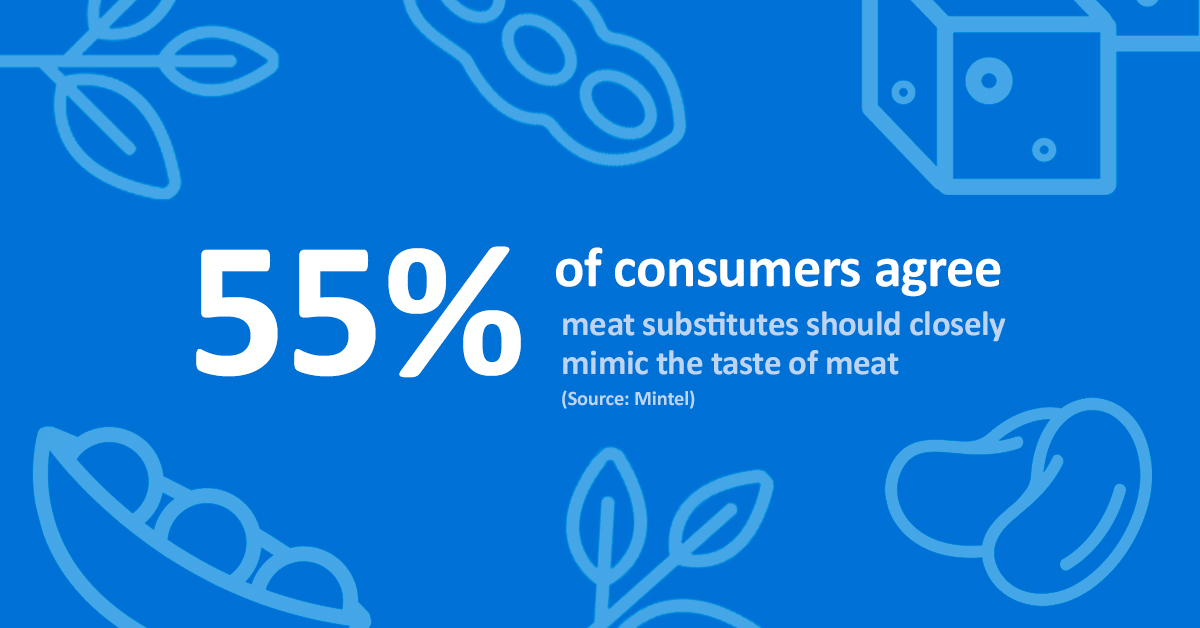The state of plant-based eating
Driven by concerns about health, wellness and sustainability — not to mention a taste for variety — a strikingly large number of consumers are interested in trying and purchasing more plant-based foods, including meat alternatives. As it stands now, the total plant-based market is estimated to be around $5.6 billion in sales, but the really interesting trend is the growth rate. The plant-based category is expected to expand nearly 30% year over year — nearly twice the rate of the overall food and beverage market. (Source: SPINS)

The landscape expands
- 28% of consumers said they were eating more protein from plant sources overall in 2020 compared to 2019, and 17% reported eating more alternative proteins in the previous year. (Source: International Food Information Council)
- BUT 98% of consumers who buy alternative proteins also buy animal meats. (Source: Plant Based Foods Association and Nielsen) and 90% of younger consumers of plant-based products also consume meat and dairy products (Source: NPD)
Everyone is in on the trend
Plant-based eating is not entirely new; it’s becoming more and more ingrained in consumers’ lifestyles. Half of Americans under the age of 50 have tried a plant-based diet. Although younger consumers are key drivers of this way of eating, trial of plant-based alternative proteins spans demographic groups, with 41% of all Americans, 42% of women and 39% of men trying such products.
Along cultural demographics, it’s a nearly even split with 42% of white Americans and 38% of nonwhite Americans both having tried plant-based proteins. (Source: Gallup)
The pandemic’s impact
Recent events accelerated the kind of dietary change that was already in motion for a few years. The International Food Information Council reports that 41% of consumers in the U.S. increased their consumption of foods from plant sources and 85% made at least some changes in how they eat or prepare foods since the pandemic began.
Adding to diets — not taking away
The fact of the matter is that plant-based foods almost always serve as an addition to consumers’ diets, not a complete replacement for animal-based products. In fact, 98% of consumers who buy meat alternatives also purchase traditional meats. Only a small percentage of consumers identify as vegan or vegetarians. Most consumers are omnivores and flexitarians who eat both meat and meat alternative products to varying degrees and frequencies. (Source: Mintel)
To underscore the concept of plant-based products as part of a new rotation of proteins, many manufacturers, retailers and foodservice operations have added plant-based offerings. Offerings of blended plant and animal proteins have emerged as another option that is attractive to consumers.
Flavor, feel and functionality
Sensory attributes are crucial in the trial and acceptance of plant-based proteins and blended products (like burger patties made with ground beef and mushrooms, or a pulled pork alternative made with jackfruit). When asked what they like most about eating or making plant-based alternative proteins, consumers cite taste, followed by texture. (Source: IFIC).

Ingredients that make plant-based proteins work
As manufacturers and processors heed growing demand for meat blends and alternatives that can be added to their portfolio of protein choices, they must meet consumers’ expectations for taste, texture, appearance, health, wellness and natural profiles.
Striking that ideal balance requires a careful use of ingredients that deliver on sensory attributes while also providing functionality. This balancing act can be complicated by consumers’ desire for foods made with familiar “real” ingredients similar to the ones they’d find in their own pantries.
We’re here to help
Since the stakes are so high for consumer acceptance, it’s important for manufacturers to develop plant-protein products that check all the boxes required of traditional proteins, including food safety, shelf life and freshness. This process can be difficult since product line additions must also fit into manufacturers’ operational realities.
Ingredients are crucial in navigating the many complexities and challenges involved in producing products and formulations made with plant proteins. To learn more, be sure to download our whitepaper, Perfecting Plant-Based Protein or contact us with any questions.


